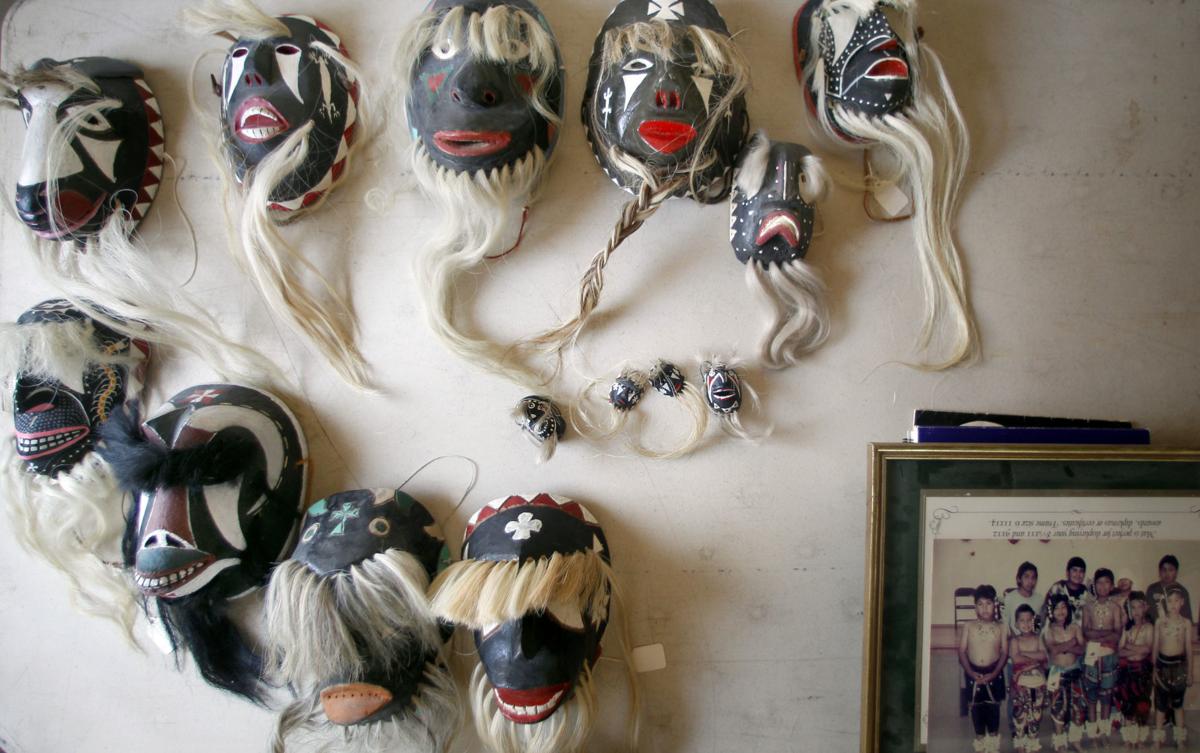At the small Yaqui enclave in South Tucson on Friday morning, under the constant whirring of vehicle and semi-truck engines, a group of men danced on the dirt plaza. The men, dressed in ceremonial garb with belts of shells and wearing sandals and masks, beat their sticks in a steady cadence. They danced, turned, stopped and repeated their pattern.
Another group of men watched from a distance and a smaller knot of women looked on as well. A murmur of a man’s voice was heard but no one else spoke at the Capilla San Martin de Porres on West 39th Street just off South 10th Avenue in South Tucson. The men were engaged in a Yaqui Lenten ritual in the shadow of the freeway interchange. This was the weekly Friday ritual that is the run-up to the Yaquis’ Easter celebrations.
Beginning next week on Palm Sunday, and in the following days and nights leading up to Easter Sunday on April 1, the Yaqui communities will be engaged in their solemn and sacred Lenten ceremonies, which stretch back more than 400 years. The Fariseos, Chapayekas, Matachinis and others will interpret in their unique way the story of the passion of Jesus Christ that the Jesuit priests introduced to the Yaquis in southern Sonora, Mexico, in the 1600s.
“We do it not only for ourselves but we do it for the world, and for those present and for the spirits of those who are not present,” said Guillermo Quiroga, a member of the Yaqui Nation and a lifelong observant and participant of the Lenten ceremonies.
The Yaquis, who refer to themselves as the Yoeme or the People, begin their ceremonies on Ash Wednesday and hold ceremonies on subsequent Fridays. And while the Easter week ceremonies are the most well-known, Quiroga said the season-long observation ends in early May with the Feast of the Santa Cruz or the Holy Cross.
On that day, he said, the Yaquis celebrate the beginning of a new cycle. The season of ceremonies is considered a time for renewal and rebirth, and when good triumphs over evil, Quiroga said.
The ceremonies are generally similar at the four sites in Tucson and only to expert eyes can small variations be seen, said Quiroga, who has participated in the various societies, or groups of dancers and musicians, revolving around the tradition.
On Good Friday, March 30, the ceremony is highlighted by the crucifixion of Christ followed by processions and an all-night vigil of the body of Christ. On Holy Saturday’s La Gloria ceremony, the figure of Judas is burned, followed by an all-night vigil. The weekend culminates on Easter Sunday morning when the maypole is unbraided, followed by Mass and the final procession.
In addition to the South Tucson site, there will be Lenten ceremonies at the nearby Capilla del Señor de los Milagros at South 16th Avenue and West 44th Street behind Pueblo Magnet High School; at Capilla Cristo Rey, 7529 S. Camino Benem at New Pascua off of West Valencia Road; and Capilla San Ignacio de Loyola at 785 W. Saguaro St. at Old Pascua near North Oracle and West Grant roads, the oldest Yaqui settlement in Tucson.
Visitors are welcomed but they are not allowed to take photographs or video of the ceremonies.
“We take it seriously,” Quiroga said. “Cellphones will be confiscated.”
The Yaquis brought their Lenten tradition to Arizona when scores of men, women and children fled, on foot, Mexican persecution and genocide beginning in the late 1800s and into the early 1900s after the outbreak of the Mexican Revolution. The Yaquis, who prided themselves as never having succumbed to Spanish colonial rule, resisted Mexican appropriation of their rich agricultural lands. Fleeing Yaquis established villages around Tucson and in Guadalupe, south of Phoenix.
Pascua, which is Spanish for Easter, was officially named as a Yaqui settlement on Easter Sunday, 1921. In 1978 the U.S. government officially recognized the Yaquis as a tribe.
Quiroga, who has helped establish a Yaqui museum at Old Pascua, said all the rituals, which require much time, effort and coordination, are important and share equal value. And increasingly more young Yaquis are learning the traditions and becoming involved in the ceremonies.
“More people are very serious about this now.”





